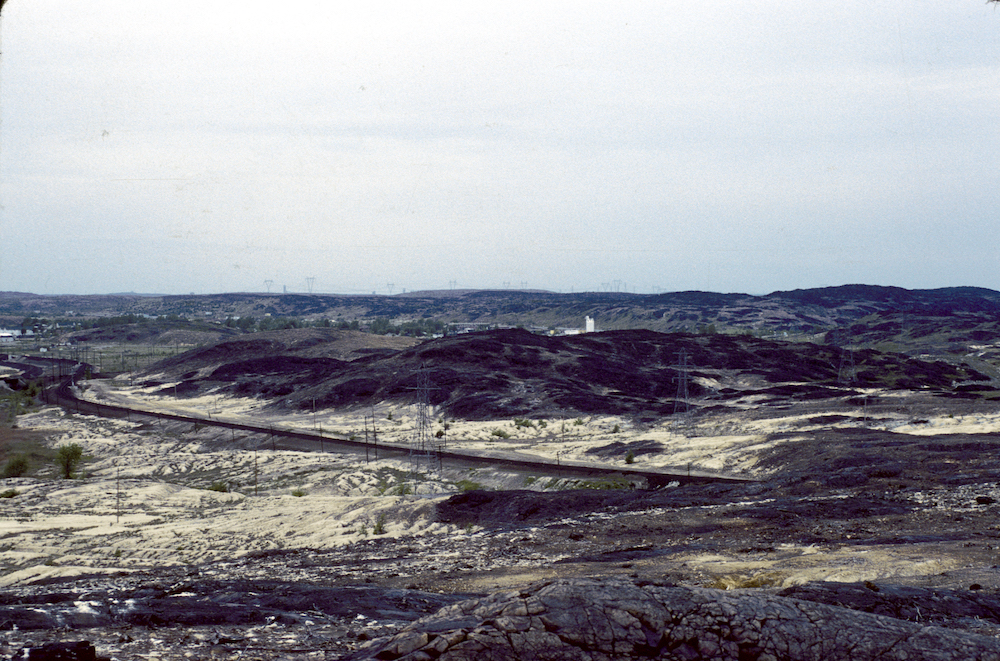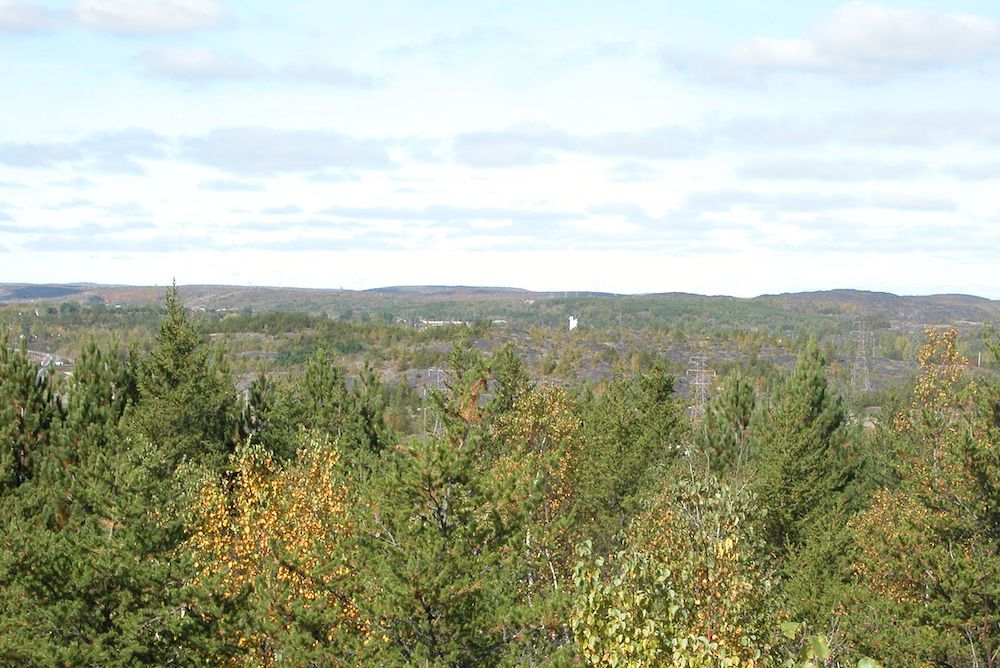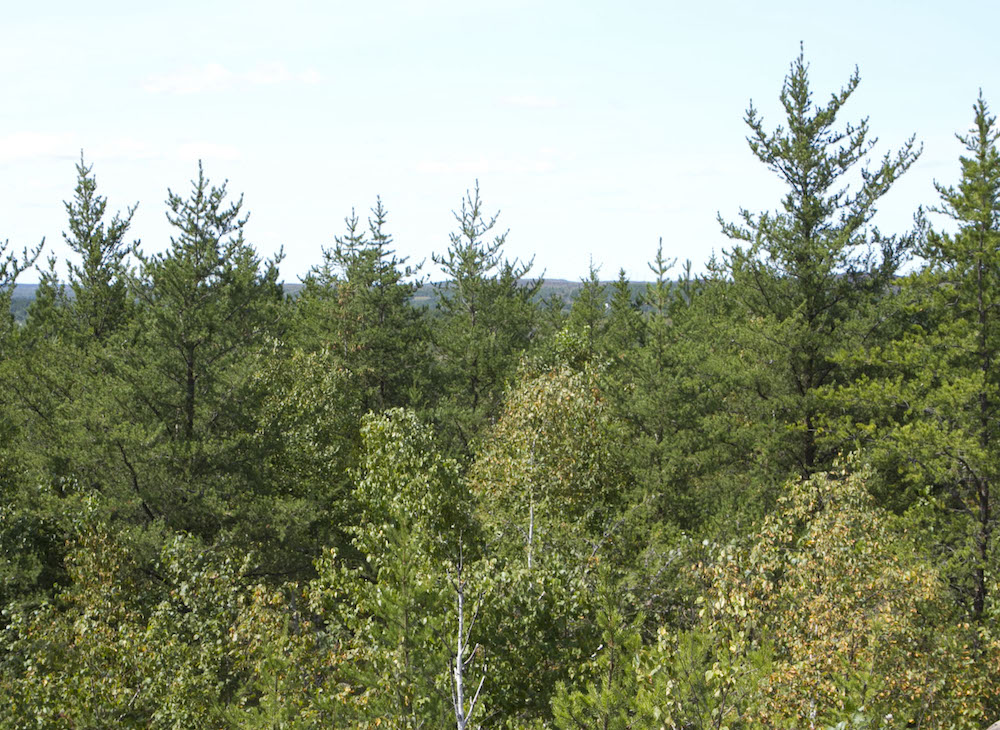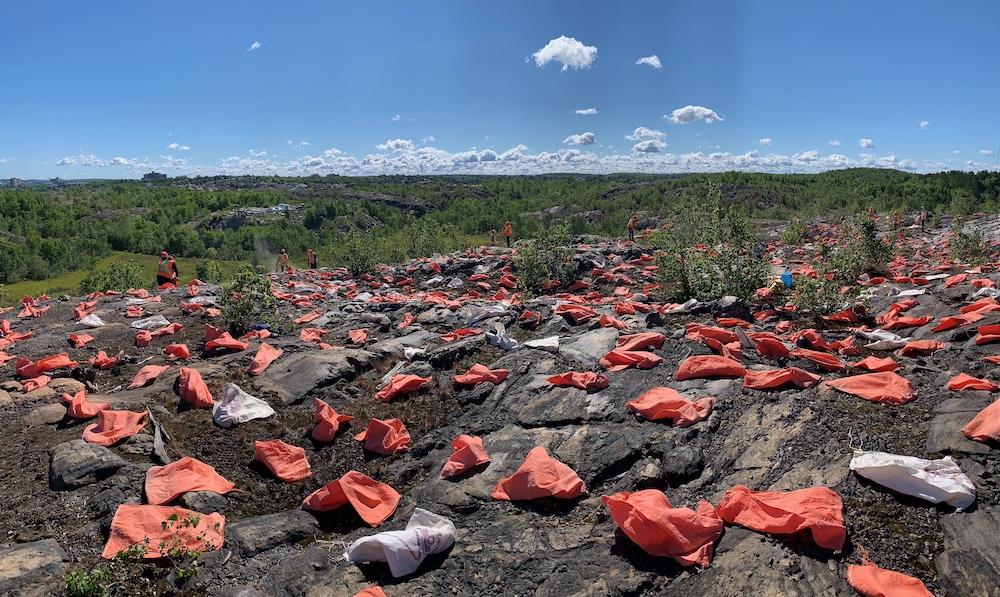Regreening the Moonscape: Greater Sudbury's remarkable ecosystem restoration
Text by Stephen Monet, OALA, and Tina McCaffrey
The United Nations declared the period between 2021 and 2030 the Decade on Ecosystem Restoration and challenges everyone to prevent, halt, and reverse the degradation of ecosystems worldwide. The City of Greater Sudbury is familiar with degraded ecosystems and their recovery. Decades of nickel smelting, starting in the late 19th century, left a footprint on the local landscape measuring roughly 82,000 hectares that was mostly devoid of vegetation. Soil on the hillsides eroded leaving exposed bedrock knobs that darkened over time from the constant assault of air-borne pollution. Soil pockets between these bedrock hills were also left bare, creating frequent dust storms—to the great annoyance of local residents. Plants could not survive the onslaught of frequent sulphur dioxide fumigations from smelters, the high soil acidity that eased the uptake of soil-borne metal particles into plant tissue, and the ongoing soil erosion that further reduced soil fertility and organic matter. On some sites, absence of vegetation and organic matter created the ideal situation for ice crystal formation at the soil surface that lifted developing tree or shrub seedlings, leaving roots exposed.



In the early 1970s, astronauts training for the Apollo 16 and 17 missions came to Sudbury to examine geological features associated with meteor impacts, such as the one that created the Sudbury Basin nearly two billion years ago. The presence of astronauts clambering on barren, rocky hillsides with makeshift equipment designed for moon exploration created an irresistible urban myth: astronauts were training in Sudbury because the landscape resembled the surface of the moon. Soon, Greater Sudbury’s landscape earned the unwelcome nickname of ‘moonscape.’ To generations of Sudburians, this landscape was home.
This dire situation was initially addressed in the 1960s through ever-increasing regulatory pollution control by the provincial government. In 1972, Inco (now Vale), built what was up to then the world’s tallest free-standing structure: the Superstack. It significantly reduced, but did not eliminate, incidences of sulphur dioxide fumigations at ground-level. Ongoing smelting and emission capture improvements by industry further reduced local sulphur dioxide levels to the point where many plants could now survive.

Elevated levels of certain metals in the soil, however, from decades of aerial deposition from the various smelter stacks, still posed a barrier to plant growth, especially when combined with the low soil pH. In the early 1970s, researchers from Laurentian University discovered that the application of crushed limestone (referred to locally as ‘liming’) at the rate of 10 tonnes per hectare was sufficient to reduce soil acidity, and thus the uptake of soil metals, to allow plant growth. Further, sowing a grass/legume seed mixture and applying a custom fertilizer mix resulted in a rapid development of a healthy sward into which pine seedlings could be planted the following year. These four steps: ‘liming,’ fertilizing, sowing a grass/legume seed mix, and tree planting became the regreening formula used to this day to kick-start the ecosystem recovery process. In 1973, a local advisory committee (VETAC – Regreening Advisory Panel) was formed to enhance and coordinate collaboration between industry, municipal, provincial and federal governments, Laurentian University, and the community. After five years of research and site-specific trials, the municipality launched its Land Reclamation Program in 1978. This Program, now known as the Regreening Program, was developed to scale up the research trials, and, since inception, has allowed thousands of temporary workers and community volunteers to apply the regreening formula to barren lands. The Program also works collaboratively with Vale, a mining company with operations in Greater Sudbury, to annually determine areas where liming, fertilizing and seeding can be done by helicopters. Forty-three years and many awards later, municipal efforts have resulted in the planting of over 10 million trees and shrubs on tens of thousands of hectares of formerly barren and semi-barren land. Local mining operators have planted at least an additional 4 million seedlings.
Decades of applying the regreening formula resulted in maturing stands of conifers. Although mixed with varying proportions of some deciduous species that colonized on their own, the resulting ‘forest’ was still relatively impoverished in terms of fungi, plants, and animals. To redress this problem, a Biodiversity Action Plan was developed with industry and community input and released in time for the launch of the United Nation’s Year of Biodiversity in 2010. The Action Plan, written in plain language, addresses the many ways in which biodiversity intersects with Greater Sudbury’s ecological recovery and community aspirations in terms of natural systems. Over the past decade, the Regreening Program has increased the number of tree and shrub species to 75. The Program has also added its Forest Floor Mat initiative, which seeks to transplant forest floor vegetation, hand dug from healthy forest areas to be developed due to highway widening or mine exploration. The vegetation mats are then watered and introduced to sufficiently mature tree stands that originate from planted tree seedlings. Since 2010, the Regreening Program has successfully introduced forest floor mats to an area roughly the size of over a dozen NHL-sized hockey rinks (2.1 hectares) scattered throughout the formerly barren lands. Plant species from these forest floor mats are already spreading several meters from their original placement and will eventually colonize the surrounding areas, bringing well-needed biological diversity to the developing forest. Numerous animal species, from frogs to bears, now claim habitat on formerly barren land. Even certain forest habitat-specialists, such as the winter wren, long-eared owl, and ovenbird nest in some areas of the recovering forest.
Now, children in Greater Sudbury have no memory of the infamous ‘moonscape’—a landscape that is rapidly vanishing locally. The Regreening Program now offers online initiatives and materials targeted at school-aged children to educate them on past conditions and the great effort required to bring about ecological recovery. The VETAC Advisory Panel also administers the annual Ugliest Schoolyard Contest that has been running locally since 2005. Each year, local schools vie for the opportunity to win substantial funding to naturalize their schoolyard with trees, shrubs, and some hardscaping. This contest is supported with a major annual financial contribution from Sudbury Integrated Nickel Operations, a Glencore Company, and donations of materials from numerous other local businesses.
Greater Sudbury’s damaged landscape has been transformed from ‘moonscape’ to living landscape with the tireless, collaborative efforts of the community, sustained financial support from industry and government, and applied research from local post-secondary educational institutions. At the start of this international Decade on Ecosystem Restoration, Greater Sudbury serves as a world-class example of how dreams can become reality.
BIO/ Stephen Monet, Ph.D., R.P.P., OALA, has over 28 years of experience in various aspects of environmental planning and management. He is currently Manager of Strategic and Environmental Planning at the City of Greater Sudbury. Among his many duties, he oversees the Regreening Program, the Lake Water Quality Program, and the Earthcare Sudbury Program. He is a licensed landscape architect as well as a registered professional planner.
Tina McCaffrey, B.Sc., has been the Supervisor of Regreening with the City of Greater Sudbury since 1994. She is a graduate of Laurentian University’s Biology Program and a native Sudburian, who has experienced the regreening transformation first-hand. In her years with the City, she has supervised nearly 1,500 temporary job positions involved in Regreening, as well as the planting of over 8 million tree seedlings.
